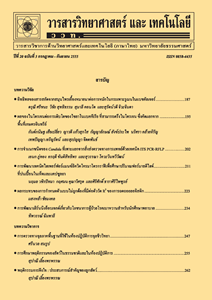ราสาเหตุโรคผลเน่าของเงาะ (Nephelium lappaceum L.) และการควบคุมโรคโดยใช้กรดซาลิไซลิก
Main Article Content
Abstract
Rambutan is a short storage period fruit and often rot damage of fresh fruits are infected by several species of fungi after harvested. This study aimed to investigate the fungal agents of rambutan fruit rot and to evaluate the efficiency of salicylic acid on controlling the disease. Rambutan fruits cv. Rongrein were obtained from eastern growing area, i.e. Rayong, Chanthaburi and Trat provinces. The results revealed that the most commonly detected fungi in decayed fruits were Gliocephalotrichum spp. (68.8 %), Pestalotiopsis spp. (62.8 %) and Lasmenia spp. (53.0 %), respectively. For pathogenicity test, Gliocephalotrichum LKS-GB3 was the most virulent. The optimum concentration of salicylic acid at 1 mM was selected for controlling the disease due to this concentration could delay disease incidence by natural infection when compared with other concentrations. It also displayed inhibitory effects on diseased fruit inoculated by Gliocephalotrichum LKS-GB3 and Lasmenia TKS-1. Salicylic acid at 1 mM had higher efficiency on reducing disease incidence of the fruit inoculated by Gliocephalotrichum than those of the fruit inoculated by Lasmenia, as 30.3 and 13.3 %, respectively. Additionally, it had similar effect on decreasing disease severity on both of inoculated fruits, as 20 and 27.1 %, respectively. The mechanism of salicylic acid on controlling the disease will be discussed.
Article Details
References
O’Hare, T.J., 1995, Postharvest physiology and storage of rambutan, Postharvest Biol. Technol. 6: 189-199.
Yingsanga, P., Srilaong, V., Kanlayarat, S., Noichinda, S. and Mc-Glasson, W.B., 2008, Relationship between browning and related enzymes (PAL, PPO and POD) in rambutan fruit (Nephelium lappaceum Linn.) cvs. Rongrien and See-Chompoo, Postharvest Biol. Technol. 50: 164-168.
Visarathanonth, N., 1983, Powdery Mildew and Fruit Rot Diseases of Rambutan and Chemical Treatments, Proceedings of the 21st Annual Conference: Plant Sciences, Kasetsart University, Bangkok, 701 p. (in Thai)
Sangchote, S., Farungsang, U. and Farungsang, N., 1997, Pre-and Post-harvest Infection of Fruit Rot Pathogens of Rambutan Fruits and Post-harvest Treatments to Control Fruit Rot Diseases, Proceedings of the 35th Kasetsart University Annual Conference: Plant, Agricultural Extension and Communi cation and Agro-Industry, Kasetsart University, Bangkok, 717 p. (in Thai)
Anonymous, Generally Recognized as Safe (GRAS) FDA. Gov. Available Source: https://www.fda.gov/Food/Food KngredientsPackaging/GenerallyRecognizedasSafeGRAS/default.htm, September 6, 2018.
Klessig, D.F. and Malamy, J., 1994, The salicylic acid signal in plants, Plant Mol. Biol. 26: 1439-1458.
Srivastava, M.K. and Dwivedi, U.N., 2000, Delayed ripening of banana fruit by salicylic acid, Plant Sci. 158: 87-96.
Zhang, Y., Chen, K., Zhang, S. and Ferguson, I., 2003, The role of salicylic acid in postharvest ripening of kiwifruit, Postharvest Biol. Technol. 28: 67-74.
Cao, J.K., Zeng, K.F. and Jiang, W.B., 2006, Enhancement of postharvest disease resistance in Ya Li pear (Pyrus bretschnei deri) fruit by salicylic acid sprays on the trees during fruit growth, Eur. J. Plant Pathol. 114: 363-370.
Hung, R.H., Liu, J.H., Lu, Y.M. and Xia, R.X., 2007, Effect of salicylic acid on the antioxidant system in the pulp of cara navel orange (Citrus sinensis L. Osbeck) at different storage temperatures, Posthar vest Biol. Technol. 47: 168-175.
Mo, Y., Gong, D., Liang, G., Han, R., Xie, J. and Li, W., 2008, Enhanced preservation effects of sugar apple fruits by salicylic acid treatment during postharvest storage, J. Sci. Food Agric. 88: 2693-2699.
Mandal, S., Mallick, N. and Mitra, A., 2009, Salicylic acid-induced resistance to Fusarium oxysporum f. sp. Lycopersici in tomato, Plant Physiol. Biochem. 47: 642-649.
Panahirad, S., Nahandi, F.Z., Safaralizadeh, R. and Alizadeh-Salteh, S., 2012, Postharvest control of Rhizopus stolonifer in peach (Prunus persica L. Batsch) fruits using salicylic acid, J. Food Saf. 32: 502-507.
Serrato-Diaz, L.M., Rivera-Vargas, L.I., Goenaga, R.J. and French-Monar, R.D., 2013, Identification of the fungal pathogen complex causing fruit rot of rambutan (Nephelium lappaceum L.) in Puerto Rico, Phytopathology 103: S2.130.
Thuwachote, S., 1983, Pathogenicity Test of 4 Plant Pathogenic Fungi Causing Fruits Rot Disease of Rambutan, Special Problem, Kasetsart University, Bangkok. 117 p. (in Thai)
Viwitjinda, S., 1980, Studies on Fruit Rot of Rambutan, Special Problem, Kasetsart University, Bangkok. 115 p. (in Thai)
Serrato-Diaz, L.M., Rivera-Vergas, L.I., Goenaga, R., Verkley, G.J.M. and French-Monar, R.D., 2011, First report of lasmenia sp. causing rachis necrosis, flower absorption, fruit rot, and leaf spots on rambutan in Puerto Rico, Phytopathology 95: 1313-1314.
Derner, J., Shah, J. and Klessing, D.F., 1997, Salicylic acid and disease resistance in plant, Trends Plant Sci. 2: 266-274.
Babalar, M., Asghari, M., Talaei, A. and Khosroshahi, A., 2007, Effect of pre- and postharvest salicylic acid treatment on ethylene production, fungal decay and overall quality of selva strawberry fruit,
Food Chem. 105: 449-453.
Yu, T., Chen, J., Chen, R., Huang, B., Liu, D. and Zheng, X., 2007, Biocontrol of blue and gray mold diseases of pear fruit by integration of antagonistic yeast with salicylic acid, Int. J. Food Microbiol. 116: 339-345.
Yao, H. and Tian, S., 2005, Effects of pre- and post-harvest application of salicylic acid or methyl jasmonate on inducing disease resistance of sweet cherry fruit in storage, Postharvest Biol. Technol. 35: 253-262.
Shafiee, M., Taghavi, T.S. and Babalar, M., 2010, Addition of salicylic acid to nutrient solution combined with postharvest treatments (hot water, salicylic acid, and calcium dipping) improved postharvest fruit quality of strawberry, Hort. Sci. 124: 40-5.
Qin, X., Xiao, H., Xue, C., Yu, Z., Yang, R., Cai, Z., and Si, L., 2015, Biocontrol of gray mold in grapes with the yeast hanseniaspora uvarum alone and in combination with salicylic acid or sodium bicarbonate, Postharvest Biol. Technol. 100: 160-167.


